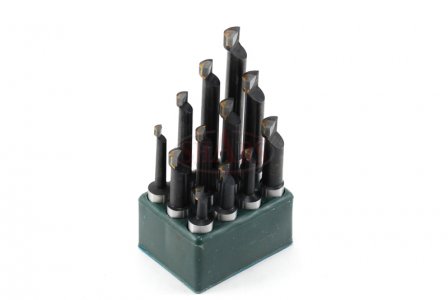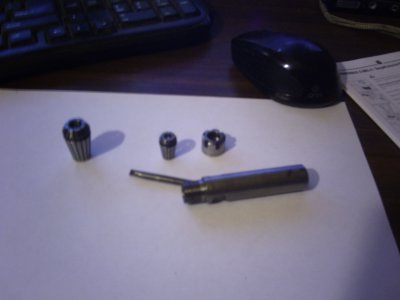- Joined
- Apr 6, 2011
- Messages
- 2,082
Well, that's where you get people thinking about differences. It's probably best to think in terms of surface speed. I know it makes you do some calculations at first, but you get used to it and it's no biggie. As far as the difference, a 1" diameter shaft spinning at XX RPM will have the same surface speed as a 1" end mill, or in a boring situation a 1" hole would require the same rpm to achieve the same surface speed. Using the 1" as an example, of course, it is π in circumference, and at (let's keep this simple) 100 RPM is running ~ 314 inches per minute, so you divide by 12 to get FPM, the common unit of measure. That's ~26 FPM, on a shaft in a lathe, running an end mill, or in boring a hole....same thing. If you know what speed you want to run, just calculate all that backwards to get the target RPM you need. It's generally not too fussy. Given the same RPM, the surface speed increases with the diameter.
With milling, you're less likely to have a situation where there is too much overhang of the work, or lack of support for the tool. In most cases that translates to an ability to run a heavier chipload. Chipload is another set of calculations based upon RPM and number of edges (single edge insert, 2, 3, 4 flute end mile, etc.) So you can push it harder, and that is also an advantage, most of the time, to carbide. Higher speed means higher temperature that the carbide can handle, higher temperature at the cutting edge itself makes the material softer and easier to cut. That's one reason carbide can be pushed so much faster than HSS. HSS will soften itself at temperatures that carbide can handle.
More material to confuse the issues..............
Nope, didn't cause any confusion, just added a bit to my meager knowledge base and gave me something else to pay attention to when I'm perusing my machining books. :thumbzup: The calcs for the surface speed are pretty straight forward and the chip load calcs, while not exactly complex still take a bit more for me to get my head around and "visualize" what is going on. Just need more experience as Metalmann suggests. What I think I took away from your "why" HSS/carbide lathe/mill explanation was basically rigidity of the overall system with the mill making the carbide cutters more viable. Did I get that right?
Ron,
Just a thought from the peanut gallery here. I can't really recoment a good boring set, but I can tell you to avoid the brazed sets like the plague. Once the edge chips, its a throw away after that. Indexable with HSS inserts would be a good idea to start with, and move to carbide later when you have done a few holes and aren't chipping the tools. I know I'm kind of late weighing in on this, but I just couldn't not say this to help keep youre expenses low while you learn. Bill Gruby does a ton of boring on the P&W he is building so you might ask him whats best too.
Bob
What little contact I've had with the brazed bits for the lathe really turned me away from even considering those. Granted it was also a lack of knowledge/experience/skills on my part but my results with HSS were so good I see no reason to go with them again. I'm sure they have their place though, like everything else in this endeavor, it's just a matter of knowing their limits and the proper way to utilize them. Good "heads up" there! You bring up the indexable tools and HSS inserts. The HSS inserts sound like they would be a great place to start, and I've even looked at the offering of Arthur Warner Co. but the selection of HSS bits seems pretty limited at least compared to carbide (I am still pretty sure I'll get some AW stuff for my lathe. I've heard too many good things about them not to try.) See my answer to Frank on the bottom, I go into more about the indexable tooling or my lack of knowledge concerning them.
"I do have to ask a follow-up question though - Why is it that the carbide cutting tools are less of an issue on the mill than they are with the lathe? Is the cutting fps that much different due to the type of cutter or what? I would think that in the case of end mills with both machines having a similar rpm the end mill cutting edge would actually "see" a slower fps than a lathe tool as long as the piece being turned on the lathe had a larger diameter than the end mill. What am I missing here?"
One thing, the bearings in a lathe are generally heavier, than a mill, quill. You have more surface area in contact, with the boring bar, using a lathe. Then again, this may be of zero use to you.
Nowadays, I just eyeball a workpiece, and know what speed, and feed; to use. :lmao:
It'll come to you. Keep your chin up.
You did lose me there a bit (not that it's a hard thing to do). I've gotten somewhat familiar with the designs of mills and lathes, at least the ones similar to what I have, although I don't yet know about the bearing in the quill. Due to the basic designs of the two I can easily see how the lathe could/would have a larger bearing than say a vertical mill head. I must be missing something in the "how" that would affect the boring bars in a lathe or mill though. It's been a long week and I'm more than likely missing lots of things.
Carbide as been around since the 40's Mostly tool bits. Now carbide endmills are common. Using the right carbide tip will give the performance desired. Like with anything else the right tool is best! For my boring I like the Komet style double positive inserts. It's a triangular tip with another grind similar to WCMT. I always get good surface finish with those inserts in my lathe, Mill and Jig Bore, also when I had HBMs. I preferred the type that had sharp corner rather than radius. I would have to go to my shop to get the correct type off the plastic container/box.
Frank
Frank, that brings up a whole "can o' worms" that I've kind of shied away from mostly due to the bewildering number of options out there. It looks like there would be some great options, if a guy actually knew what he was doing. I, definitely don't fit in that category. Heck, there are so many different bars, heads, etc. and they all seem to use different and somewhat proprietary bits causing a mental melt-down (okay, maybe just some tepid gray matter in my case). Case in point, you say that you "prefer the Komet style double positive" which I would barely know from a nail in a tree stump and "types with sharp corners vs. radius?", I don't have the experience or knowledge to decide or know which to put in an order for therefore I can look at the catalogs for hours on end (and I do) but can't arrive at an intelligent decision on which tool or tips would be right for my applications. Truly, my hat's off to you and the rest of you guys that have that stuff figured out.
Thanks guys,
-Ron



